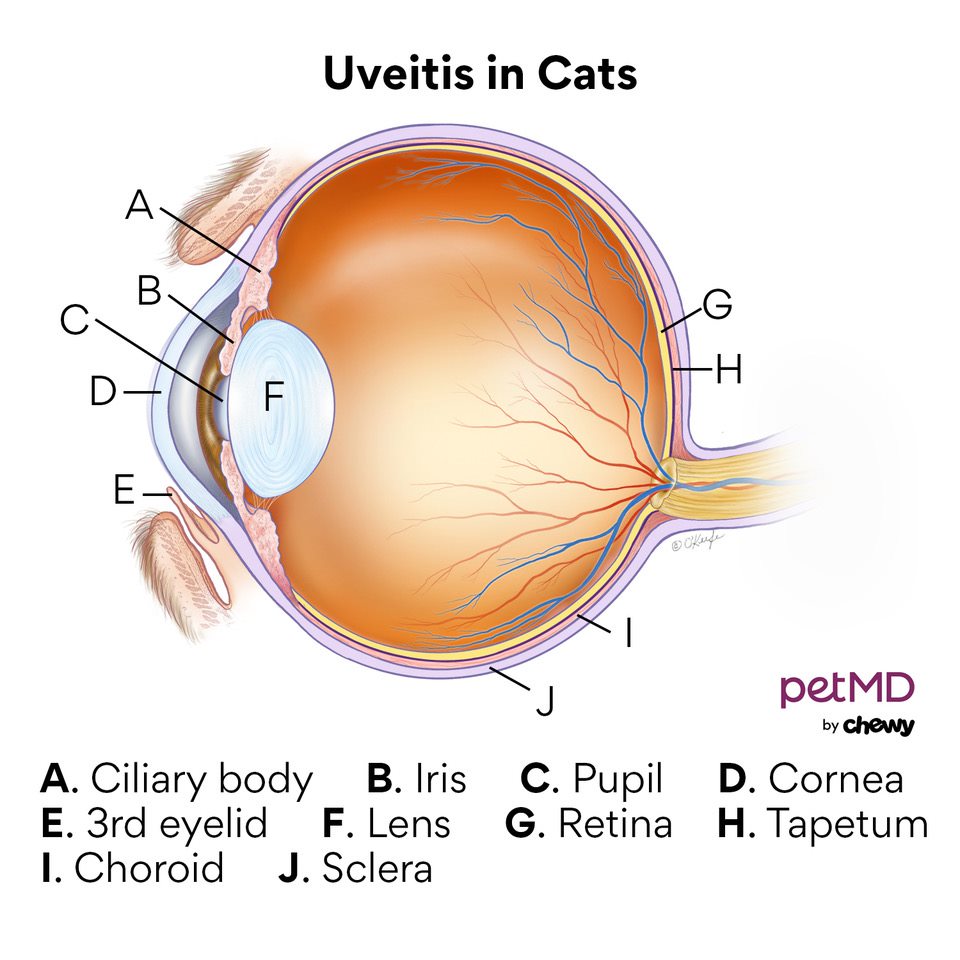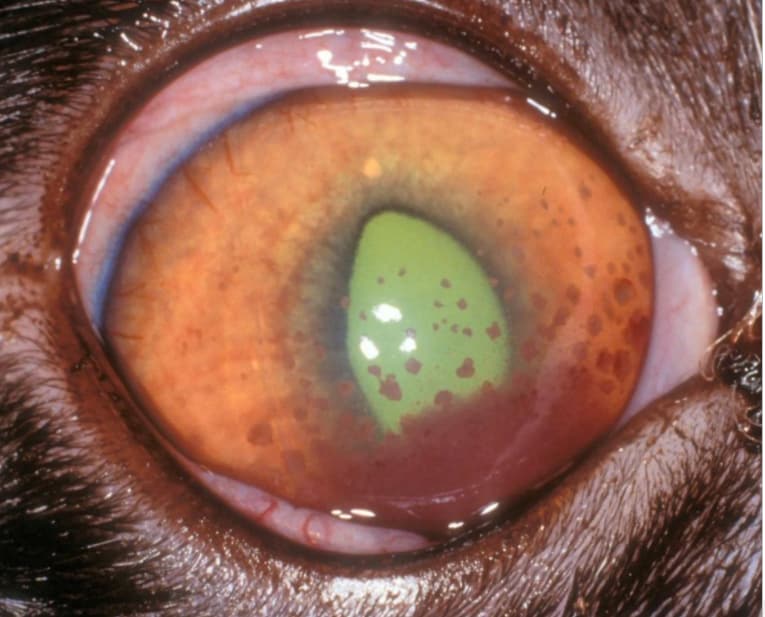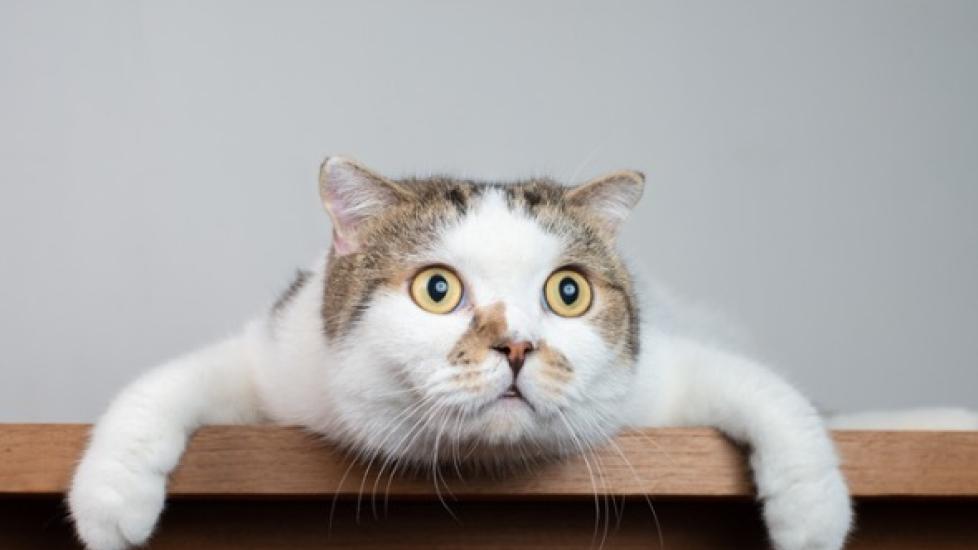Uveitis in Cats
What Is Uveitis in Cats?
Uveitis in cats is an inflammation of the uvea (also known as the uveal tract), which is a part of the eye that includes the iris, the ciliary body, and the choroid.
-
Iris. The iris is the colored portion of your cat’s eye directly surrounding the pupil. The job of the iris is to control the size of the pupil, which helps determine the amount of light that’s allowed to reach the retina (eye lining that translates light signals to the brain).
-
Ciliary Body. The ciliary body is the middle layer of the eye that connects the two other parts of the uvea (the iris and the choroid). Its muscles help the eye focus by changing the size of the pupil and the lens shape. The ciliary body produces fluid, called aqueous humor, which provides oxygen and nutrients to the lens and the cornea (clear, outermost cover of the eye).
-
Choroid. The choroid is a vascular layer (full of vessels) of the eye that contains melanin cells (natural skin pigment). These cells absorb light, limit reflection, and protect the blood vessels against light toxicity (too much light). The choroid’s melanin cells also provide oxygen and blood supply to the outer retina.

Symptoms of Uveitis in Cats
Eye conditions in cats tend to be sneaky, and uveitis is no different. That’s because cats are good at hiding their illnesses and may simply hide more when they aren’t feeling their best or are in pain.
Cat uveitis can have an acute or sudden onset, or it can develop slowly and remain undetected for some time.
Because uveitis can cause blindness, the only thing you may notice is your cat’s sudden disappearance, as this condition would certainly be alarming to them and cause them to retreat.
If you do notice physical signs, either one or both of your cat’s eyes can be affected. Most often, a notably “red eye” is seen. Your cat may squint, appear to be sensitive to light, and have a watery eye. This is because uveitis is painful.
The color of your cat’s iris may be altered or cloudy. Pupil size may be affected, along with your cat’s vision, though this can be harder to detect. If glaucoma (buildup of pressure that damages the optic nerve) accompanies the uveitis, your cat’s eye may be enlarged or seem to stick out.
If a generalized infection or virus is involved in uveitis, your cat may act ill and show other clinical signs depending upon the particular issue.

Image Credit: Courtesy of KN Gelatt, 2022
Causes of Cat Uveitis
There are two general categories for causes of cat uveitis:
-
Ocular, or having to do with the eye
-
Systemic causes
Ocular Causes of Uveitis in Cats
Ocular causes include:
-
Tears on the surface of the eye or within the cornea (the outermost cover of the eye), called corneal ulcers
-
Trauma to the eye
-
Cataracts (clouding of the eye lens)
-
Tumors
Systemic Causes of Uveitis in Cats
Systemic causes of cat uveitis are extensive. They include noninfectious systemic causes and various infectious causes. In addition, there are some cases of uveitis that are immune-mediated.
Noninfectious causes:
-
Eating fatty foods
Infectious causes:
-
Feline infectious peritonitis, also known as FIP (viral)
-
Feline immunodeficiency virus, also known as FIV (viral)
-
Histoplasmosis (fungal)
-
Blastomycosis (fungal)
-
Cryptococcosis (fungal)
-
Coccidioidomycosis (fungal)
-
Candidiasis (fungal)
-
Toxoplasmosis (parasitic)
-
Cuterebra larval migration (parasitic)
Immune-mediated causes:
-
Drug reactions
-
Vaccine reactions
-
Toxins
-
Other systemic disease processes
Unfortunately, immune-mediated disease is difficult to understand and sometimes difficult to attribute to an underlying cause. Medications that change the functioning of the immune system are usually started to treat the clinical signs.
If a systemic cause (such as infection) is not determined to be affecting the immune system, then often a cause for the uveitis is never diagnosed. This is called idiopathic uveitis.
How Vets Diagnose Cat Uveitis
Your veterinarian will want to know if your cat has experienced any other physical symptoms at home (such as weight loss, decreased appetite, vomiting, or diarrhea), as well as details about your cat’s home environment and exposure to other animals.
In addition to a complete physical examination, your veterinarian will perform an ophthalmic exam. Your vet will likely also recommend specific eye tests to evaluate the surface of the cornea for any abrasions, measure eye pressure, and measure tear production.
Basic blood work may also be necessary, as well as tests to rule out any infections that may have caused the uveitis. Some of these tests may include:
-
Complete blood count
-
Biochemistry panel
-
Feline leukemia test
-
FIV test
-
Toxoplasmosis test
Treatment for Uveitis in Cats
Treatment of uveitis includes therapy targeted at the specific causes, if they can be identified, as well as generalized therapy.
Specific therapy may include medications for high blood pressure, for instance. For noncurable infectious causes, such as FIV, treatment is aimed at reducing your cat’s symptoms and supporting them through their flare-ups.
Your vet may prescribe topical eye medications and systemic medications to alleviate pain and decrease inflammation. Examples of these include:
-
Atropine
-
Prednisolone acetate
-
Topical NSAIDs
In the case of tumors in the eye, surgery will likely be necessary.
Recovery and Management of Cat Uveitis
Many cases of feline uveitis are resolved via a veterinary visit for a thorough examination, diagnostic testing, and medication therapy. Your cat will have a follow-up visit for the vet to assess healing and resolution of the condition.
Other cats are less fortunate and will require months of treatment. Cats with fungal infections typically require lengthy treatment, as the underlying fungal cause can be difficult to eliminate.
As with all eye conditions, recheck visits for uveitis in cats are essential to gauge the effectiveness of treatment and monitor the progression of your cat’s healing.
You will also need to monitor your cat at home to make sure their symptoms don’t come back, as uveitis can result in blindness or the loss of the eye when left untreated.
Uveitis in Cats FAQs
Is uveitis contagious in cats?
Not typically, although a few types of cat uveitis may be associated with infectious diseases that have the potential to spread.
Can uveitis in cats be cured?
Yes, usually. Take your cat to the emergency vet if you see any symptoms.
Help us make PetMD better
Was this article helpful?
